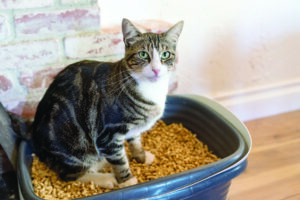By Dr. Beth Leermakers
Clumping. Non clumping. Clay. Crystal. Biodegradable. Health monitoring.
With so many options, choosing a kitty litter can be daunting for new (and experienced) cat parents. Does it really matter what goes in your cat’s litter box?
Yes — especially if your cat isn’t using her litter box. Cats are finicky creatures who have definite preferences. Here’s the scoop on cat litter.

What Are the Options?
Many cats are picky about their litter, and they will let you know if it’s not working for them. Most cats prefer unscented, clumping litter that is medium-fine textured.
Clay. Most (about 92 percent) of cat litters are made from clay. Clay litter is highly absorbent, able to absorb its weight in cat urine. When it becomes soiled and can’t absorb more liquid, odor becomes problematic. Some clay litters include baking soda or charcoal to improve odor control.
You must clean and change clay litter frequently. Because non-clumping clay litter doesn’t form clumps that are easily removed with a scoop, the litter box needs to be emptied, cleaned and the litter replaced at least once a week. A particular type of clay (Bentonite) allows some litter (“clumping”) to clump when it’s wet.
Silica (often called crystal litter). About two percent of litters are made from Silica gel, similar to the desiccant (drying agent) crystals in those little packets in shoe boxes, food and medications that warn “do not eat.” Your cat would have to eat a lot of the litter to be in danger.
Silica gel can absorb about 35 percent of its weight in water without swelling. Silica gel absorbs the liquid and odors instead of clumping, so you only need to remove the solid waste. This litter needs to be changed every four weeks, making it lower maintenance than clay litter. Silica litters produce less dust than clay litters, making them a better choice for cats or people with allergies or asthma.
Biodegradable. Biodegradable litters are made from recycled paper or plant-based materials (pine, wheat, corn, beet pulp and soybean). These litters appeal to people who worry about their cat eating clay or silica litter (although your cat would have to ingest a large amount to cause problems). Because biodegradable litters don’t clutter landfills, they are a good choice for people who prefer eco-friendly products.
Health monitoring. Litters such as Pretty Litter and Fresh Step Crystals Health Monitor Litter change color in response to certain disease markers in a cat’s urine, helping owners spot early signs of illness before more serious symptoms arise. Cats — especially older or overweight ones — are prone to urinary problems. Health-monitoring cat litters detect potential problems in a cat’s urinary tract: the kidneys, bladder and the plumbing that connects them. Health monitoring litters are more expensive than traditional clay or crystal litters. Pretty Litter costs $24 for a 6-lb. bag that lasts about a month for a one-cat household. The litter is available by subscription through Pretty Litter, or through online retailers (e.g., Chewy, WalMart).
Made of silica, health monitoring litters detect changes in pH by changing color. Any pH values that are outside the normal range for cat urine (6.3 – 6.6) could mean your cat is sick. Because pH can change for harmless reasons, pH by itself isn’t a very useful diagnostic tool. Veterinarians consider pH values in the context of other symptoms and risk factors (age, diet, medical history).
Scientists from C&EN (Chemical and Engineering News) tested the pH-indicating power of Pretty Litter and discovered that the litter does detect changes in pH. Their at-home tests found that the indicator litter turned bright blue when they added baking soda in water (pH of about 8) and orangey-yellow when they added vinegar water (pH of around 3).
Are these expensive health monitoring litters worth it? Maybe. Indicator litters may be a good tool for early detection of urinary tract issues in your cat. However, they are NOT meant to be a substitute for good veterinary care or definitive diagnostic tests like urinalysis.
If the litter detects an abnormal pH, you need to consult your vet.
Jody Lulich, DVM, PhD, considers at-home pet health monitoring to be positive because it leads to communication between pet parents and vets, and that may result in better health outcomes. “It doesn’t hurt anything but your pocketbook,” says Lulich. “Anytime you can pick up disease early and not go overboard with tests that may hurt, then the answer is it should be good.”
As you select a litter, consider these questions:
• Will my cat reliably use the litter box if I use this litter?
• Does the litter aggravate allergies (my cat’s or human family members’)?
• Do I mind the odor?
• How often am I willing to empty and replace the litter?
• Does it fit my budget?
Using the Litter Box
Should Be Pleasant
Whatever litter you choose, keep these tips in mind:
• The litter box should be big enough (1 and 1/2 times the length of your cat) for your cat to stand in and do his business without feeling crowded.
• Provide plenty of litter boxes for multiple-cat families (at least 1 box/cat, plus one extra).
• Put the box somewhere private and quiet (not in the laundry room where a noisy dryer may be frightening), away from children and dogs.
• Your cat shouldn’t have to travel far to reach his litter box (especially if he’s older). Put one box on each floor of a multiple-story house.
A happy, healthy cat makes for a happy household.
